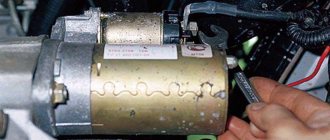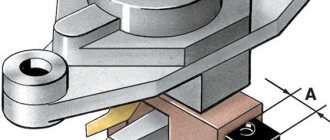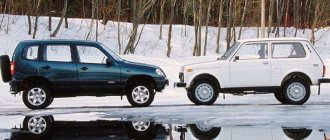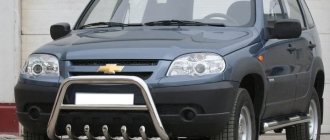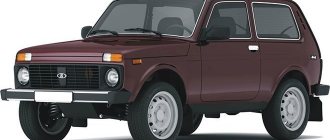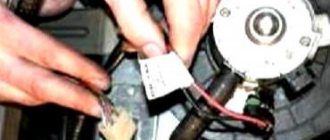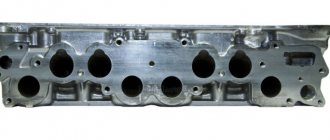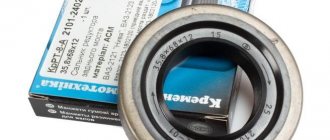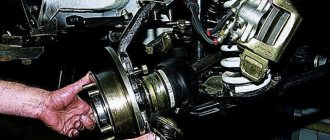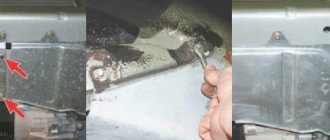Description of problems with the starter and ways to solve them on the VAZ 21213
On Niva, most of the components are quite reliable and do not require frequent repairs. But there are a number of standard breakdowns characteristic of the vehicle in question. Most often, the starter does not turn for the following reasons:
- turn-to-turn short circuit in the solenoid winding - the relay needs to be replaced;
- open circuit of the power supply - it is necessary to check the connections between connections No. 50 and No. 86 (the most common places of oxidation);
- the relay armature is stuck - it is necessary to replace the armature.
If the solenoid relay is activated, but the starter does not rotate or rotates very slowly, then you must:
- poor contact on the tips and terminals of the battery - it is necessary to stretch it and clean it from deposits;
- the commutator contacts are burnt, the brushes are stuck - you need to clean the commutator and replace the carbon brushes;
- there is a short circuit in the brush holder - it is necessary to replace the cover on the commutator side.
Sometimes it happens that the starter rotates. But the engine flywheel remains motionless. Perhaps the reason lies in clutch slipping. To determine the exact cause and repair, you will need to remove the starter and check it on the stand. The problem can only be solved by replacing the coupling. Sometimes extraneous noise occurs when the starter rotates. The reasons for this may be the following:
- The bearing bushings and armature shaft journals are worn out – the starter needs to be replaced;
- The starter is loose.
To solve most problems that arise during operation, you will need to remove the starter. This procedure may require dismantling the injector. Testing at the stand will not take much time. But it will allow you to determine the exact cause of the malfunction. There is a wide range of breakdowns. They usually occur on cars with mileage of more than several tens of thousands of kilometers.
Please note the following points:
Blow the Niva casing and brush holder with air. Lubricate the underwater ring with a lubricating compound (Litol will do). Treat the shaft splines and bushings with engine oil. Proper repair of the starter is a guarantee of a smooth start of the engine both hot and cold. The main thing is to diagnose the malfunction in a timely manner and correct it correctly.
The starter on a Niva rarely has to be changed, but if you have a need for this, the instructions below will be very useful. First, it’s worth considering the necessary list of tools with which doing all this will be very simple and will not take much time.
- Key for 13
- Ratchet with small extension
- Head for 10
Do-it-yourself VAZ 21213 starter repair video
05/28/2018 admin Comments No comments
The Niva 21213 and 21214 cars have a starter with mixed-type excitation, with an electromagnetic-type traction relay and two independent windings. Four poles are fixed in the housing, one of which is connected in parallel, and the rest in series. The casing and cover are tightened using a pair of bolts. Inside there is an armature with a collector (the latter is of the end type). The armature rotates on metal-ceramic bushings pressed into the covers.
Despite the apparent design complexity, starter repair is accessible even to beginners. The main thing is to have the necessary tools on hand, diagnose the problem in a timely manner and follow the manufacturer’s instructions. Below we will look at what starter malfunctions exist and how to fix the problems.
How to recognize a breakdown?
During operation, the following problems are possible: 1. After turning the key in the ignition switch, the Niva car does not start, the starter does not turn. Causes of the problem:
- The machine's power supply has run out.
- The terminals on the battery or the terminals of the connected wires are oxidized.
- The terminals are poorly stretched.
- Interturn short circuit or damage to the traction relay winding.
- The switching starter relay has failed or there is a break in the power supply wire of the device.
- Lack of closure between the “thirtieth” and “fiftieth” contacts.
In the cases described above, the faulty element is replaced or repaired, and the contacts are cleaned.
2. When the key is turned in the ignition switch, the relay works, but the starter does not turn (hot or cold). Causes:
- The battery is discharged or damaged.
- The fastening of the lugs of the wire connecting the engine with the body part has been loosened.
- The “plus” and (or) “minus” on the power source is oxidized, poor traction.
- The commutator was burnt and the brushes were worn out.
- The positive terminal of the brush holder was at ground.
- There is a break in the armature and (or) stator windings.
Possible breakdowns and malfunctions
It is worth thinking about replacing the starter if the car owner notices that:
- The plastic on the plastic cover of the relay began to melt; the power contacts easily turn inside the cover.
- Relay coils are damaged.
- When the control wire was removed, the power contacts were not turned off or were turned on in a free order, which resulted in breakage of the spring. Since most solenoid relays cannot be disassembled, it is not possible to inspect the spring.
- The starter does not start spinning the first time, it jams.
- The power contacts are burnt. The voltage at the contacts of the solenoid relay is less than 0.5 Volts.
If severe external defects appear, you cannot do without purchasing a new starter.
Specific problems and methods for solving them
If it is difficult to turn on the VAZ 21214 engine, there is a possibility that the problem lies in the starter. The most common breakdown is that the starter may not turn, even when the ignition is started. Note that the starter relay is located very close to the ignition relay, under the additional. fuse block.
Let's get acquainted with the typical malfunctions of the Niva starter:
Breakdown Checking and diagnostics How to get rid of the problem The starter solenoid relay is inoperative You cannot hear a click under the hood when you turn the key. If you close the circuit with a handy tool, the starter begins to turn. The starter does not turn when the engine is warm (hot). Complete replacement of the part (retractor relay). The battery is low. Despite the click, the starter does not move. When consumers are turned on, the voltage at the battery terminals does not exceed 12V. Replace/charge the battery. The starter armature winding is damaged and a short circuit has occurred. To check the serviceability of the mechanism, use an ohmmeter
Also pay attention to places where the insulation has changed color. Darkening indicates problems. Complete replacement of components (starter). The battery terminals are oxidized and poorly connected. Even though the starter clicks, it does not turn over.
If you turn it on, the voltage at the starter/battery terminals varies greatly. The contact connections must be thoroughly cleaned, coated with Vaseline or other lubricant, and then tightened tightly. The ground contact is broken, the relay contacts are oxidized. The starter does not turn even after a click. The car won't start. For diagnostics, it is necessary to measure the resistance in the circuit, as well as the performance of the relay as a whole. 1) Completely replace the solenoid relay with a new one. 2) Clean the contacts well, lubricate them with a protective compound and tighten tightly. Flywheel ring teeth/drive gear are damaged. It is enough to conduct a visual inspection of the components to notice a malfunction. Flywheel replacement, starter replacement or repair. The freewheel slips. The starter continues to move, but the flywheel remains in place. Complete replacement of starter/clutch. Rotating the ring gear on the flywheel. The starter turns, but the flywheel/crankshaft does not. The clutch housing makes unnatural sounds. Buying a new flywheel and replacing it completely. The starter commutator is burnt, the brushes are very worn/stuck. Remove the starter and make sure how tightly the commutator is pressed against the brushes. Determine commutator wear and remaining brush height. If the commutator is worn out as much as possible, the starter will have to be replaced. The damage is minor - just have it repaired or go to a salon. The ignition contacts (50 and 30) cannot close and the solenoid relay wiring is inoperative. The relay does not operate when the key is turned. The car owner must measure the voltage at the relay control contact. Replacing the ignition switch, cleaning contacts. Attachments/engine jams. Visual check of the coolant pump, as well as the crankshaft and power steering pump. If problems are detected, the attachments/engine itself will need to be repaired.
How to remove the heat shield without removing the starter?
How to remove the heat shield without removing the starter?
Post by Niva867 » 08 Jun 2012, 16:52
There is a problem. You need to get to the wires to the starter, remove them, and clean the contacts in order for it to start. I don't need to remove the starter at all, I just need to remove the heat shield. The heat shield is secured with 3 bolts, 2 at the top, 1 at the bottom. I unscrewed them. But the heat shield cannot be pulled out. I tried it in front, and back, and up and down. Then he turned it around and went to drink beer.
Re: How to remove the starter heat shield?
Post by Anton » Jun 08, 2012, 04:57 pm
How to remove the Niva 21214 starter in 10 minutes. The cause of the malfunction of the removed starter NIVA VAZ 21214
Published on August 29, 2016
Preparation for quick removal of the starter in extreme conditions. Quickly remove the starter and eliminate the cause of a possible malfunction. How to remove an acoustic pipe from a Niva receiver Why is an acoustic pipe needed? As you noticed, the lower bolt of the starter was never intentionally screwed in again, after the first removal of the starter during the initial period of operation of the car. Also, the heat shield of the starter, whose lower mounting bolt quickly sticks when driving through mud, was not put in place. Because of this, in order to remove the screen, you have to cut off the lower attachment point or tear the screen itself. I don't want to go through this procedure a second time. The fact that there is no lower mounting bolt for the starter and a heat shield has its advantage for field drivers who often operate their vehicles, for example, in the conditions of Siberian swamps, river fords and frosts. Very often the cause of a starter malfunction is simple. For example, as in this video, or even funnier - the red wire (also shown in the video) from the solenoid relay has simply oxidized or weakened. It is enough to MOVE it and the starter will spin. You can make the starter spin if the nickels in the solenoid relay are burned by closing (carefully, with something not large in size, but massive and iron, without touching the mass of the engine body) the power wires on the solenoid relay. It's easy to do all this without a screen. And if necessary, the starter can be easily removed. It happens, for example, that the starter breaks down, and the car is parked at the entrance, and it’s -30 outside! Yes, even in the summer! You still need to remove the starter. Negotiate with your neighbor about a garage? Or take it to service? But you can remove it EASILY AND QUICKLY yourself, right at the entrance. Buy a new starter or solenoid relay from your local store. And an hour later the car drove off. And if the car is parked in a puddle or mud, then crawl under the car and turn the bottom bolt? In short, there are many life situations where the absence of a bolt and a heat shield will greatly simplify your life. The author of the video does not pretend that others will perceive his opinion and his proposed method of solving the problem as the only correct one. Decide this for yourself. The author simply suggested the option: “How to remove the Niva 21214 starter in 10 minutes and determine the cause of the malfunction of the removed Niva 21214 starter.” There will also be solutions to problems encountered in the Niva on the channel. If you are interested, subscribe.
It's better to put up protection. Otherwise, in the heat, the starter will overheat and catch the wedge.
For + Stanislav G. I don’t argue. But according to my experience of operating several fields, in the difficult mountain conditions of Altai in the summer, in the hottest months. Constantly reduced, etc. And from morning to evening we move through the mountains and swamps. All this summer, having come on vacation from Siberia on a field, I exploited a field in the Krasnodar region, stood in traffic jams in the heat for 2-3 hours, getting to the sea and from the sea back to friends in Krasnodar. The engine was not turned off. And so the whole vacation. So in the Krasnodar region, in the heat and in traffic jams, without a screen on the starter, there have been no problems yet. I have been using Niva for 25 years in both Siberian frosts and heat. The starter never caught a wedge. The statistics of my use so far are as follows: the absence of a screen did not affect the operation of the starter. The downside may be this: without a screen, the lubricant inside the starter dries out faster. But usually the starter fails due to something other than dry lubricant. In some fields, starters worked for 5-10 years without problems, without a screen. Then the car was sold. It is difficult to judge further statistics. I initially received all the Nivas (mostly) with good mileage. In addition to the first one bought back in the USSR and another one, which he himself drove from Tolyatti to Siberia. Again, I don't insist. Decide for yourself.
Main block with fuses and relays
This block is located to the left of the steering column and is closed from below with a lid.
To get to it, you need to tighten 2 screws, then press the top edge of the cover and gradually free it from all fasteners. The block that appears will be held on a special bracket. The fuse diagram itself and the number of elements on it may vary depending on the configuration and year of manufacture.
photo of the fuse box in a Chevrolet Niva
Scheme - option 1
Scheme - option 2
- Explanation of fuses
- F1 (5 A) - license plate lamps, instrument panel lamps, indicator light on the dashboard, engine compartment lamp, additional brake light lamp, left side marker lamps.
- If any of the listed lamps do not work, check this fuse and the lamps themselves, their connectors and wiring.
F2 (7.5 A) - low beam in the left headlight. Similar to relay K4.
F3 (10 A) - high beam in the left headlight, indicator lamp for turning on the high beam headlights on the dashboard. Similar to relay K5.
F4 (10 A) - backup fuse.
F5 (30 A) - front door electric windows and their relays. If, when operating the power window, the window goes down but not up (or vice versa), check the button on the door.
When lowering and raising, the polarity and direction of rotation of the motor are different. It could also be a problem with the window lift mechanism. To get to it, you need to remove the door trim. Check that the mechanism does not bite anywhere and that the gears are intact, without broken teeth.
If there are problems, you can replace the entire power window drive with a new one.
F6 (15 A) - door lock control unit. If one or more doors stop opening, check this fuse. The issue may be in the central locking, control unit, as well as the mechanisms themselves, rods and door locks. If you have no experience, it is better to contact a car service.
F7 (20 A) - sound signal and its relay, cigarette lighter. If the horn does not work, check this fuse, the steering column contacts and the wiring; the contacts may have oxidized and the wiring may have become frayed.
